From the Trenches
Cause of Death
By JASON URBANUS
Monday, April 06, 2015
 On July 18, 1329, Cangrande della Scala, the ruler of Verona, triumphantly marched through Treviso after conquering the rival city. Four days later he was dead, purportedly having drunk from a polluted spring. But the true cause of his death has been a nearly 700-year-long mystery, replete with rumors and accusations of poisoning. Since 2004, when Cangrande’s body was exhumed from its tomb in the church of Santa Maria Antiqua in Verona, Italian researchers have been conducting a multidisciplinary examination of the remains, including archaeological, palaeopathological, toxicological, and palynological analysis. Their recent findings suggest that the Veronese prince was a victim of foul play.
On July 18, 1329, Cangrande della Scala, the ruler of Verona, triumphantly marched through Treviso after conquering the rival city. Four days later he was dead, purportedly having drunk from a polluted spring. But the true cause of his death has been a nearly 700-year-long mystery, replete with rumors and accusations of poisoning. Since 2004, when Cangrande’s body was exhumed from its tomb in the church of Santa Maria Antiqua in Verona, Italian researchers have been conducting a multidisciplinary examination of the remains, including archaeological, palaeopathological, toxicological, and palynological analysis. Their recent findings suggest that the Veronese prince was a victim of foul play.
Pollen samples taken from Cangrande’s digestive system, as well as samples from his liver and hair, unexpectedly revealed the presence of digitalis, commonly known as foxglove. Foxglove leaves are fatal when consumed in certain quantities, and Cangrande’s remains exhibited lethal doses of its toxins. Historical sources indicate that in the days prior to his death, Cangrande suffered from fever, vomiting, and diarrhea, all of which are consistent with foxglove poisoning. Although researchers can’t count out the possibility that Cangrande accidentally consumed the plant, they believe the demise of such a healthy and relatively young man was the result of deliberate poisoning. In addition to the foxglove, the palynological tests also indicated traces of chamomile and black mulberry, suggesting that Cangrande was served a decoction of various plants to mask the poison. The perpetrators of the crime remain unknown, though some suggest responsibility lies with rival Italian rulers, his own heirs, or even his personal physician, who is rumored to have been executed shortly after Cangrande’s death.
Medicine on the High Seas
By MARION BLACKBURN
Monday, April 06, 2015
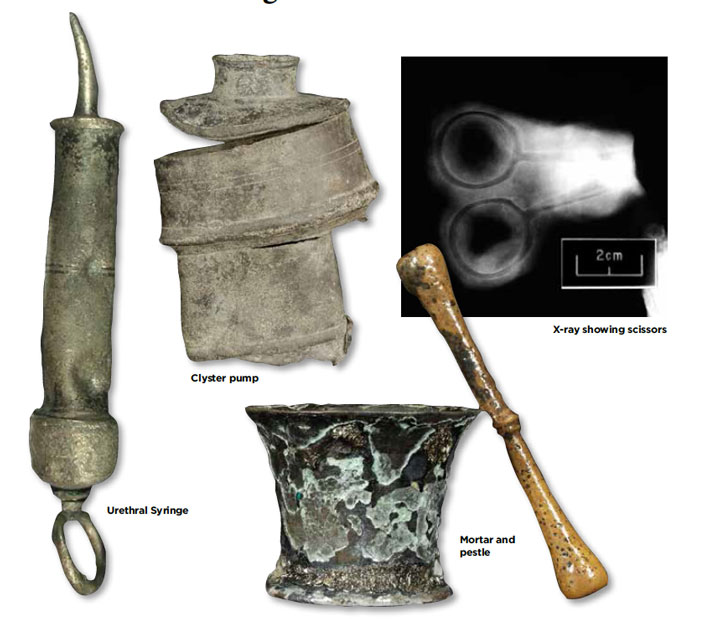
A urethral syringe, clyster pump, mortar and pestle, needle, and scissors found at the wreck site of Queen Anne’s Revenge off the North Carolina coast hint that medical care was commonplace on Blackbeard’s flagship, and that crew members likely suffered from a variety of unsavory conditions. Linda Carnes-McNaughton, archaeologist and long-time volunteer with the excavation project, presented the medical finds at the annual Society of Historical Archaeology meeting in January 2015. She associated artifacts from the shipwreck with period treatments for illnesses such as dysentery (or “bloody flux”), scurvy, and syphilis. Her discoveries are not for the squeamish. For syphilis, or the “great pox,” mercury was injected into the urethra. Dysentery, constipation, or fever called for an enema, or clyster, of chamomile, cork ash, tobacco, brandy, wine, or vinegar. The blend depended on the symptoms. The treatments would have been state of the art in Blackbeard’s heyday in 1717 and 1718.
For Sarah Watkins-Kenney, lab director and chief conservator for the Queen Anne’s Revenge project, Carnes-McNaughton’s research provides an additional dimension to the ship’s significance to researchers. “It demonstrates what can be learned from this assemblage of artifacts,” she says. “It will tell us more about seafaring life in the early eighteenth century.”
Telecom History Deep Beneath the Pacific
By SAMIR S. PATEL
Monday, April 06, 2015
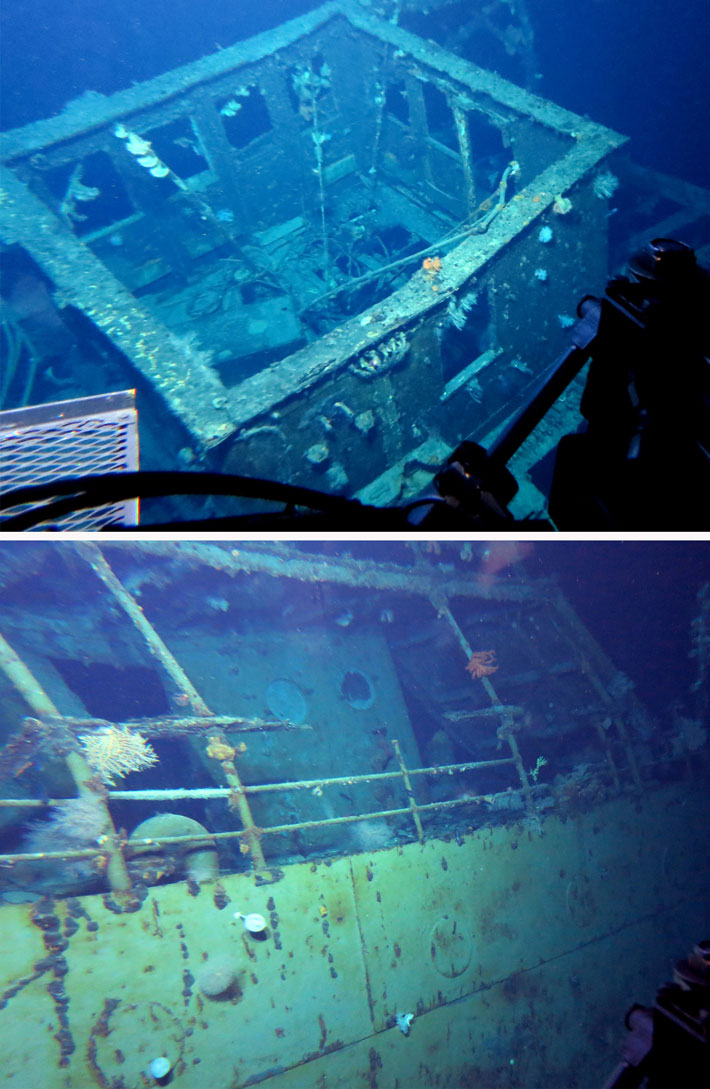 A significant piece of global telecommunications history has been found 2,000 feet below the waves near Oahu. Using the manned submersible Pisces V, Terry Kerby of the Hawaii Undersea Research Laboratory and researchers from the University of Hawaii at Manoa and the National Oceanic and Atmospheric Administration discovered the wreck of Dickenson, a commercial vessel that repaired and serviced the undersea cables that made global communications possible in the early twentieth century. The ship was launched in 1923 and served remote Pacific communications stations until 1941, when it was chartered by a British telecommunications company to evacuate employees from Fanning Island. Dickenson arrived in Honolulu Harbor with the evacuees on December 7, 1941, just hours before the attack on Pearl Harbor. During the war, the ship was chartered by the U.S. Navy, dubbed USS Kailua, and set to work maintaining cable and submarine nets. The recent mission found the vessel upright and intact, raising doubts about the report that it had been sunk by a torpedo when it was retired from service in 1946. “It looks to me like the USS Kailua was scuttled and settled peacefully on the bottom,” says Kerby, “and looks like she is sailing off into the dark like a ghost ship.”
A significant piece of global telecommunications history has been found 2,000 feet below the waves near Oahu. Using the manned submersible Pisces V, Terry Kerby of the Hawaii Undersea Research Laboratory and researchers from the University of Hawaii at Manoa and the National Oceanic and Atmospheric Administration discovered the wreck of Dickenson, a commercial vessel that repaired and serviced the undersea cables that made global communications possible in the early twentieth century. The ship was launched in 1923 and served remote Pacific communications stations until 1941, when it was chartered by a British telecommunications company to evacuate employees from Fanning Island. Dickenson arrived in Honolulu Harbor with the evacuees on December 7, 1941, just hours before the attack on Pearl Harbor. During the war, the ship was chartered by the U.S. Navy, dubbed USS Kailua, and set to work maintaining cable and submarine nets. The recent mission found the vessel upright and intact, raising doubts about the report that it had been sunk by a torpedo when it was retired from service in 1946. “It looks to me like the USS Kailua was scuttled and settled peacefully on the bottom,” says Kerby, “and looks like she is sailing off into the dark like a ghost ship.”
How Grass Became Maize
By ZACH ZORICH
Monday, April 06, 2015
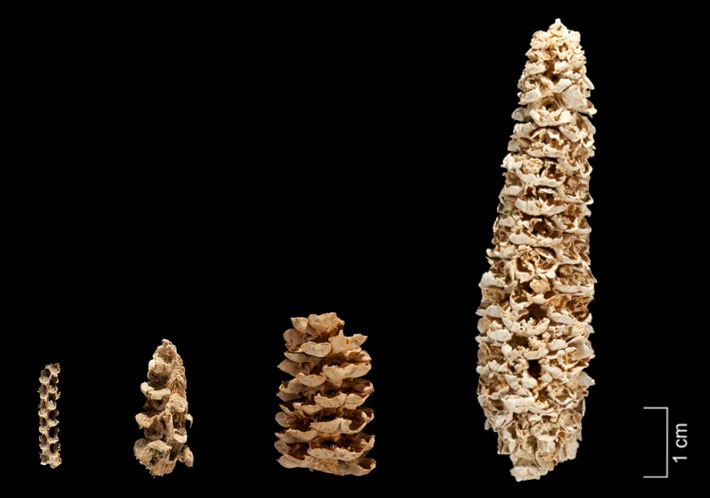
By about 6,000 years ago, people in Mexico had domesticated a tropical grass called teosinte, beginning a process that would radically alter the plant, turning it into maize, responsible for feeding people across the world today. A team of archaeologists and biochemists recently documented the genetic changes the plant underwent in the southwestern United States. Their results show that the earliest maize in the region was a drought-resistant variety that came from the highlands of Mexico about 4,000 years ago. Sometime between 2,000 and 750 years ago, that highland maize was either accidentally cross-pollinated or intentionally bred with a starchier coastal maize variety, which likely improved its nutritional value. According to Rute da Fonseca, a biochemist at the University of Copenhagen, understanding maize evolution can help us understand how the cultures that consumed maize changed along with it. Cultivated maize can be stored and eaten year-round and requires less work to farm than most other crops. “It frees you, it gives you more free time for other things,” says Fonseca. “Maize allowed for the development of more complex societies.”
Viking Trading or Raiding?
By ERIC A. POWELL
Monday, April 06, 2015
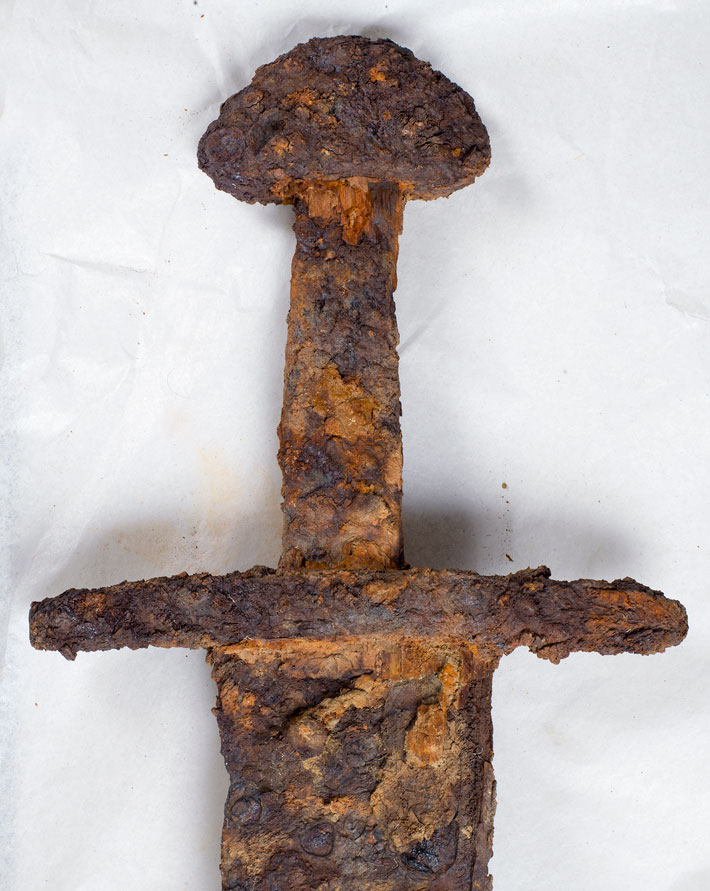 Last year, the discovery of an ax head on a mountaintop overlooking Norway’s Trondheim Fjord led archaeologists to a tenth-century Viking grave. Though they found no remains, the team recovered a sword and a shield boss. The discovery seemed routine, until the boss was X-rayed. “We could see there was stuff in there,” says archaeologist Ingrid Ystgaard of the Norwegian University Science and Technology’s Museum of Natural History and Archaeology. It turned out to contain a leather purse holding Islamic silver coins that were minted in what is now Iraq, along with agates and a small lead weight. “I’ve never seen anything like it,” says Ystgaard. “It’s extremely rare to find coins in Viking burials, and so far as I know, none have ever been found in a shield boss.”
Last year, the discovery of an ax head on a mountaintop overlooking Norway’s Trondheim Fjord led archaeologists to a tenth-century Viking grave. Though they found no remains, the team recovered a sword and a shield boss. The discovery seemed routine, until the boss was X-rayed. “We could see there was stuff in there,” says archaeologist Ingrid Ystgaard of the Norwegian University Science and Technology’s Museum of Natural History and Archaeology. It turned out to contain a leather purse holding Islamic silver coins that were minted in what is now Iraq, along with agates and a small lead weight. “I’ve never seen anything like it,” says Ystgaard. “It’s extremely rare to find coins in Viking burials, and so far as I know, none have ever been found in a shield boss.”
Ystgaard points out that Vikings were known to travel as far as Constantinople, and the agates and coins could have been obtained through either trading or raiding. Extensive marks on the sword and shield boss show that they had been used in combat, but the lead weight secreted inside suggests the warrior may have at least occasionally played the role of merchant. “It’s a good reminder that they were not just raiders,” says Ystgaard. “This man was likely a classic trader-warrior of the Viking Age.”
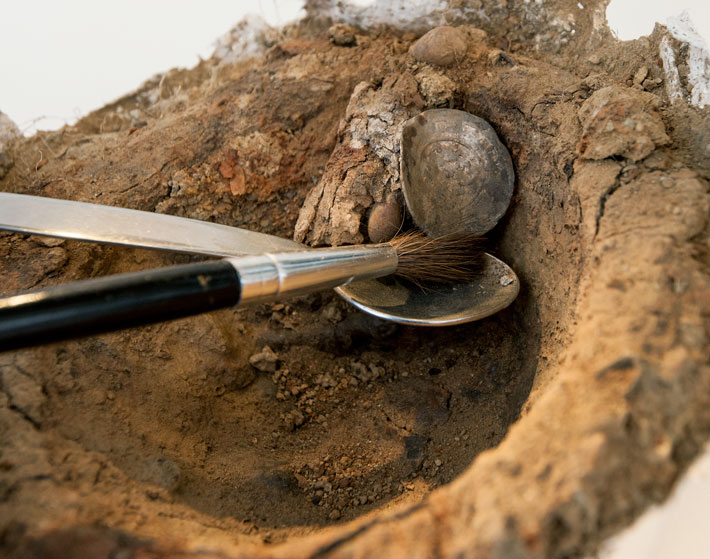
Advertisement
Advertisement
IN THIS ISSUE
From the Trenches
The Charred Scrolls of Herculaneum
Off The Grid
Viking Trading or Raiding?
Telecom History Deep Beneath the Pacific
How Grass Became Maize
Medicine on the High Seas
Cause of Death
A Western Wiki-pedia
Catching Fire and Keeping It
Oysters for the Earth Goddess
Ant Explorers
A Soul of a City
A Slice of Parasitic Life
The Price of a Warship
Medieval Leather, Vellum, and Fur
A Shipwreck in Drydock
Mongol Fashion Statement
Advertisement

Recent Issues
-
 May/June 2024
May/June 2024
-
 March/April 2024
March/April 2024
-
 January/February 2024
January/February 2024
-
 November/December 2023
November/December 2023
-
 September/October 2023
September/October 2023
-
 July/August 2023
July/August 2023
-
 May/June 2023
May/June 2023
-
 March/April 2023
March/April 2023
-
 January/February 2023
January/February 2023
-
 November/December 2022
November/December 2022
-
 September/October 2022
September/October 2022
-
 July/August 2022
July/August 2022
-
 May/June 2022
May/June 2022
-
 March/April 2022
March/April 2022
-
 January/February 2022
January/February 2022
-
 November/December 2021
November/December 2021
-
 September/October 2021
September/October 2021
-
 July/August 2021
July/August 2021
-
 May/June 2021
May/June 2021
-
 March/April 2021
March/April 2021
-
 January/February 2021
January/February 2021
-
 November/December 2020
November/December 2020
-
 September/October 2020
September/October 2020
-
 July/August 2020
July/August 2020
-
 May/June 2020
May/June 2020
-
 March/April 2020
March/April 2020
-
 January/February 2020
January/February 2020
-
 November/December 2019
November/December 2019
-
 September/October 2019
September/October 2019
-
 July/August 2019
July/August 2019
-
 May/June 2019
May/June 2019
-
 March/April 2019
March/April 2019
-
 January/February 2019
January/February 2019
-
 November/December 2018
November/December 2018
-
 September/October 2018
September/October 2018
-
 July/August 2018
July/August 2018
-
 May/June 2018
May/June 2018
-
 March/April 2018
March/April 2018
-
 January/February 2018
January/February 2018
-
 November/December 2017
November/December 2017
-
 September/October 2017
September/October 2017
-
 July/August 2017
July/August 2017
-
 May/June 2017
May/June 2017
-
 March/April 2017
March/April 2017
-
 January/February 2017
January/February 2017
-
 November/December 2016
November/December 2016
-
 September/October 2016
September/October 2016
-
 July/August 2016
July/August 2016
-
 May/June 2016
May/June 2016
-
 March/April 2016
March/April 2016
-
 January/February 2016
January/February 2016
-
 November/December 2015
November/December 2015
-
 September/October 2015
September/October 2015
-
 July/August 2015
July/August 2015
-
 May/June 2015
May/June 2015
-
 March/April 2015
March/April 2015
-
 January/February 2015
January/February 2015
-
 November/December 2014
November/December 2014
-
 September/October 2014
September/October 2014
-
 July/August 2014
July/August 2014
-
 May/June 2014
May/June 2014
-
 March/April 2014
March/April 2014
-
 January/February 2014
January/February 2014
-
 November/December 2013
November/December 2013
-
 September/October 2013
September/October 2013
-
 July/August 2013
July/August 2013
-
 May/June 2013
May/June 2013
-
 March/April 2013
March/April 2013
-
 January/February 2013
January/February 2013
-
 November/December 2012
November/December 2012
-
 September/October 2012
September/October 2012
-
 July/August 2012
July/August 2012
-
 May/June 2012
May/June 2012
-
 March/April 2012
March/April 2012
-
 January/February 2012
January/February 2012
-
 November/December 2011
November/December 2011
-
 September/October 2011
September/October 2011
-
 July/August 2011
July/August 2011
-
 May/June 2011
May/June 2011
-
 March/April 2011
March/April 2011
-
 January/February 2011
January/February 2011
Advertisement






